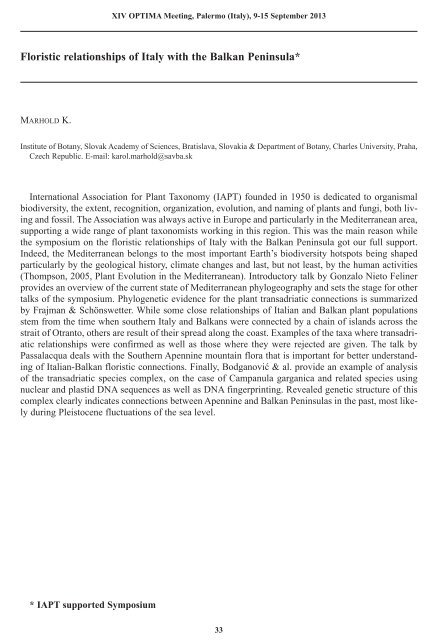Abstracts, XIV OPTIMA Meeting, Palermo (Italy) , 9-15
Abstracts, XIV OPTIMA Meeting, Palermo (Italy) , 9-15
Abstracts, XIV OPTIMA Meeting, Palermo (Italy) , 9-15
You also want an ePaper? Increase the reach of your titles
YUMPU automatically turns print PDFs into web optimized ePapers that Google loves.
<strong>XIV</strong> <strong>OPTIMA</strong> <strong>Meeting</strong>, <strong>Palermo</strong> (<strong>Italy</strong>), 9-<strong>15</strong> September 2013<br />
Floristic relationships of <strong>Italy</strong> with the Balkan Peninsula*<br />
MARHOLD K.<br />
Institute of Botany, Slovak Academy of Sciences, Bratislava, Slovakia & Department of Botany, Charles University, Praha,<br />
Czech Republic. E-mail: karol.marhold@savba.sk<br />
International Association for Plant Taxonomy (IAPT) founded in 1950 is dedicated to organismal<br />
biodiversity, the extent, recognition, organization, evolution, and naming of plants and fungi, both living<br />
and fossil. The Association was always active in Europe and particularly in the Mediterranean area,<br />
supporting a wide range of plant taxonomists working in this region. This was the main reason while<br />
the symposium on the floristic relationships of <strong>Italy</strong> with the Balkan Peninsula got our full support.<br />
Indeed, the Mediterranean belongs to the most important Earth’s biodiversity hotspots being shaped<br />
particularly by the geological history, climate changes and last, but not least, by the human activities<br />
(Thompson, 2005, Plant Evolution in the Mediterranean). Introductory talk by Gonzalo Nieto Feliner<br />
provides an overview of the current state of Mediterranean phylogeography and sets the stage for other<br />
talks of the symposium. Phylogenetic evidence for the plant transadriatic connections is summarized<br />
by Frajman & Schönswetter. While some close relationships of Italian and Balkan plant populations<br />
stem from the time when southern <strong>Italy</strong> and Balkans were connected by a chain of islands across the<br />
strait of Otranto, others are result of their spread along the coast. Examples of the taxa where transadriatic<br />
relationships were confirmed as well as those where they were rejected are given. The talk by<br />
Passalacqua deals with the Southern Apennine mountain flora that is important for better understanding<br />
of Italian-Balkan floristic connections. Finally, Bodganović & al. provide an example of analysis<br />
of the transadriatic species complex, on the case of Campanula garganica and related species using<br />
nuclear and plastid DNA sequences as well as DNA fingerprinting. Revealed genetic structure of this<br />
complex clearly indicates connections between Apennine and Balkan Peninsulas in the past, most likely<br />
during Pleistocene fluctuations of the sea level.<br />
* IAPT supported Symposium<br />
33






